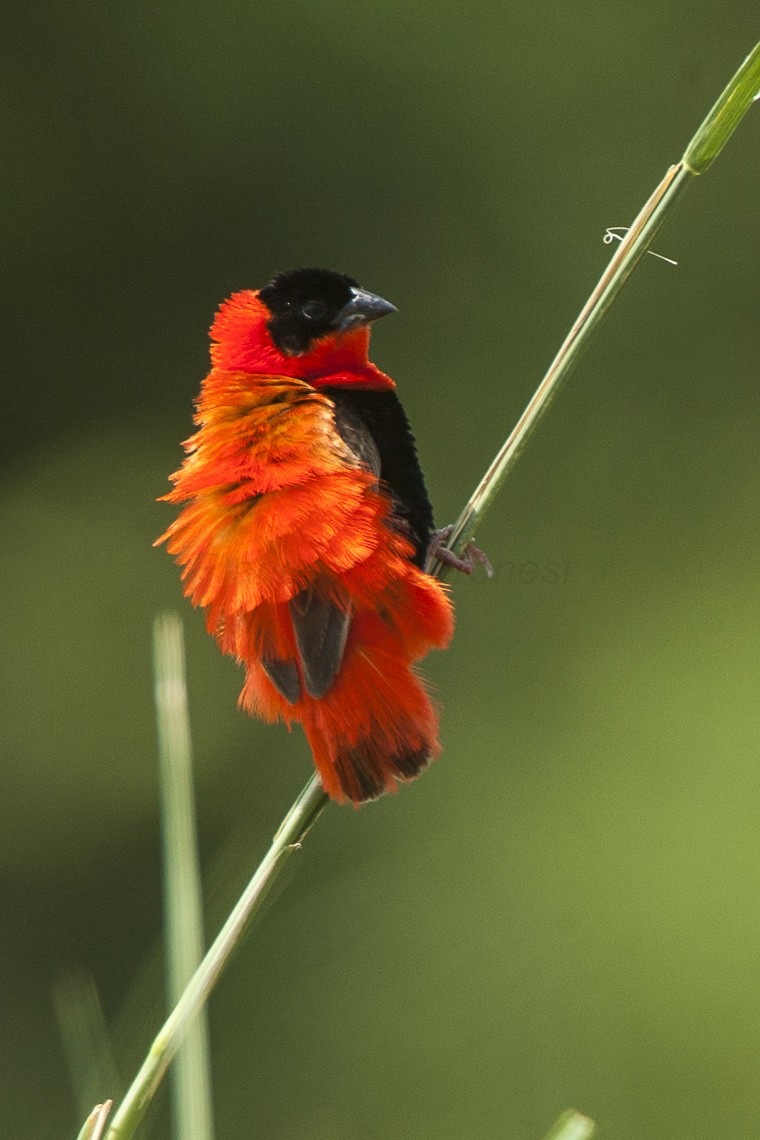Northern Red Bishop
A species of Bishops and widowbirds Scientific name : Euplectes franciscanus Genus : Bishops and widowbirds
Northern Red Bishop, A species of Bishops and widowbirds
Botanical name: Euplectes franciscanus
Genus: Bishops and widowbirds
Content
Description General Info
 Photo By Francesco Veronesi , used under CC-BY-SA-2.0 /Cropped and compressed from original
Photo By Francesco Veronesi , used under CC-BY-SA-2.0 /Cropped and compressed from original Description
This short-tailed bishop is small in size, about 11 cm and weighing about 12-22 grams. The striking red-orange feathers are produced by pigments derived from compounds in their diet. Specifically, the yellow, orange, and red pigments originate from compounds called carotenoids, which are very diet-dependent. Lutein and two red fractions (R1 and R2) derived from lutein are the two dominating carotenoids that contribute to the bird's pigment in the wild. Northern red bishops held in captivity lack the R2 red fraction carotenoid from their diet. This plumage is present on the backside of the male and wraps around the chin to back of the head, throat, and breast, with a dark black crown, forehead, flank, and belly. The tail and upper wings are brown, with pale legs and a black bill. This plumage, the identifier of the northern red bishops, is only present in the breeding males. Females and non-breeding males have a dilute brown and white feather pattern, similar to that of a song sparrow. Males entering breeding season transition into this bright and brilliant plumage, and eventually they molt these display feathers at the end of the breeding season to acquire the plumage close to that of the females. 
Size
11-14 cm (4.5-5.5 in)
Colors
Brown
Black
Yellow
Red
Gray
Orange
Life Expectancy
12 years
Nest Placement
Shrub
Feeding Habits
Northern Red Bishop primarily consume grass seeds, including Echinochloa and millet, with a partiality for aquatic vegetation and insects. They forage on the ground or in vegetation, adopting versatile hunting techniques, and may join seed feeders in late winter. Northern Red Bishop form flocks with other species off-season.
Habitat
Northern Red Bishop thrives in open or bushy grasslands and prefers seasonally flooded regions for nesting. Their habitat extends to tall crop landscapes, such as rice and maize fields, and the weedy fringes of cultivated land. Geographically, northern Red Bishop's range encompasses wetlands, coastal lowlands, and elevations from 600 to 2000 meters. Introduced populations exist in the West Indies and United States.
Nest Behavior
Male northern Red Bishop performs courtship displays and constructs the nest. Females lay eggs, which are then jointly cared for by both parents.
Nest Characteristics
Northern Red Bishop's nest is spherical, built with plant stems, and lined inside with finer materials. It has a side entrance and is typically located in reeds or bushes.
Dite type
Granivorous
General Info
Feeding Habits
Bird food type
Distribution Area
The northern red bishop has a wide distribution across northern Africa. This species inhabits northern Liberia, southern Mauritania, Senegambia, Guinea, north Sierra Leone, east Eritrea, Ethiopia, northwest and southern Somalia, northeast Democratic Republic of the Congo, North Uganda, Burkina Faso, northern Ivory Coast, South Chad, North Cameroon, Sudan, and Kenya. Northern red bishops generally reside in tall grasslands or cultivated areas near water and marshes. This species has been observed in lowlands to elevations as high as 1000 meters. Though first inhabiting Africa, this species was introduced to Puerto Rico in the 1960s, and has since been reported throughout the West Indies. The northern red bishop has been reported in Martinique, Guadeloupe, Barbados, Jamaica, and St. Croix, U.S. Virgin Islands, along with recorded occurrences in Cuba. In recent decades, the northern red bishop were introduced to areas of the United States, including southern California, Texas, and Hawaii. In 1997, the estimated population size of northern red bishops in Los Angeles and Orange counties reached 400. A small population also resides in Harris County, TX. 
Species Status
Not globally threatened.
Scientific Classification
Phylum
Chordates Class
Birds Order
Perching birds Family
Weavers Genus
Bishops and widowbirds Species
Northern Red Bishop